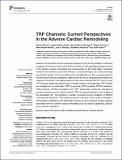Por favor, use este identificador para citar o enlazar a este item:
http://hdl.handle.net/10261/200434COMPARTIR / EXPORTAR:
 SHARE SHARE
 CORE
BASE CORE
BASE
|
|
| Visualizar otros formatos: MARC | Dublin Core | RDF | ORE | MODS | METS | DIDL | DATACITE | |

| Título: | TRP Channels: Current Perspectives in the Adverse Cardiac Remodeling |
Autor: | Falcón, Debora CSIC ORCID; Galeano-Otero, Isabel; Calderón-Sánchez, Eva CSIC; Toro, Raquel del CSIC ORCID; Martín-Bórnez, Marta CSIC ORCID CVN; Rosado, Juan A.; Hmadcha, Abdelkrim CSIC ORCID; Smani, Tarik CSIC ORCID | Palabras clave: | Calcium TRP channels Cardiac remodeling Hypertrophy Fibrosis Conduction disorders |
Fecha de publicación: | 1-mar-2019 | Editor: | Frontiers Media | Citación: | Frontiers in Physiology 10: 159 (2019) | Resumen: | Calcium is an important second messenger required not only for the excitation-contraction coupling of the heart but also critical for the activation of cell signaling pathways involved in the adverse cardiac remodeling and consequently for the heart failure. Sustained neurohumoral activation, pressure-overload, or myocardial injury can cause pathologic hypertrophic growth of the heart followed by interstitial fibrosis. The consequent heart’s structural and molecular adaptation might elevate the risk of developing heart failure and malignant arrhythmia. Compelling evidences have demonstrated that Ca2+ entry through TRP channels might play pivotal roles in cardiac function and pathology. TRP proteins are classified into six subfamilies: TRPC (canonical), TRPV (vanilloid), TRPM (melastatin), TRPA (ankyrin), TRPML (mucolipin), and TRPP (polycystin), which are activated by numerous physical and/or chemical stimuli. TRP channels participate to the handling of the intracellular Ca2+ concentration in cardiac myocytes and are mediators of different cardiovascular alterations. This review provides an overview of the current knowledge of TRP proteins implication in the pathologic process of some frequent cardiac diseases associated with the adverse cardiac remodeling such as cardiac hypertrophy, fibrosis, and conduction alteration. | Versión del editor: | https://doi.org/10.3389/fphys.2019.00159 | URI: | http://hdl.handle.net/10261/200434 | DOI: | 10.3389/fphys.2019.00159 | E-ISSN: | 1664-042X |
| Aparece en las colecciones: | (IBIS) Artículos (CABIMER) Artículos |
Ficheros en este ítem:
| Fichero | Descripción | Tamaño | Formato | |
|---|---|---|---|---|
| fphys-10-00159.pdf | 1,2 MB | Adobe PDF |  Visualizar/Abrir |
CORE Recommender
PubMed Central
Citations
34
checked on 14-abr-2024
SCOPUSTM
Citations
47
checked on 16-abr-2024
WEB OF SCIENCETM
Citations
44
checked on 25-feb-2024
Page view(s)
181
checked on 18-abr-2024
Download(s)
121
checked on 18-abr-2024

